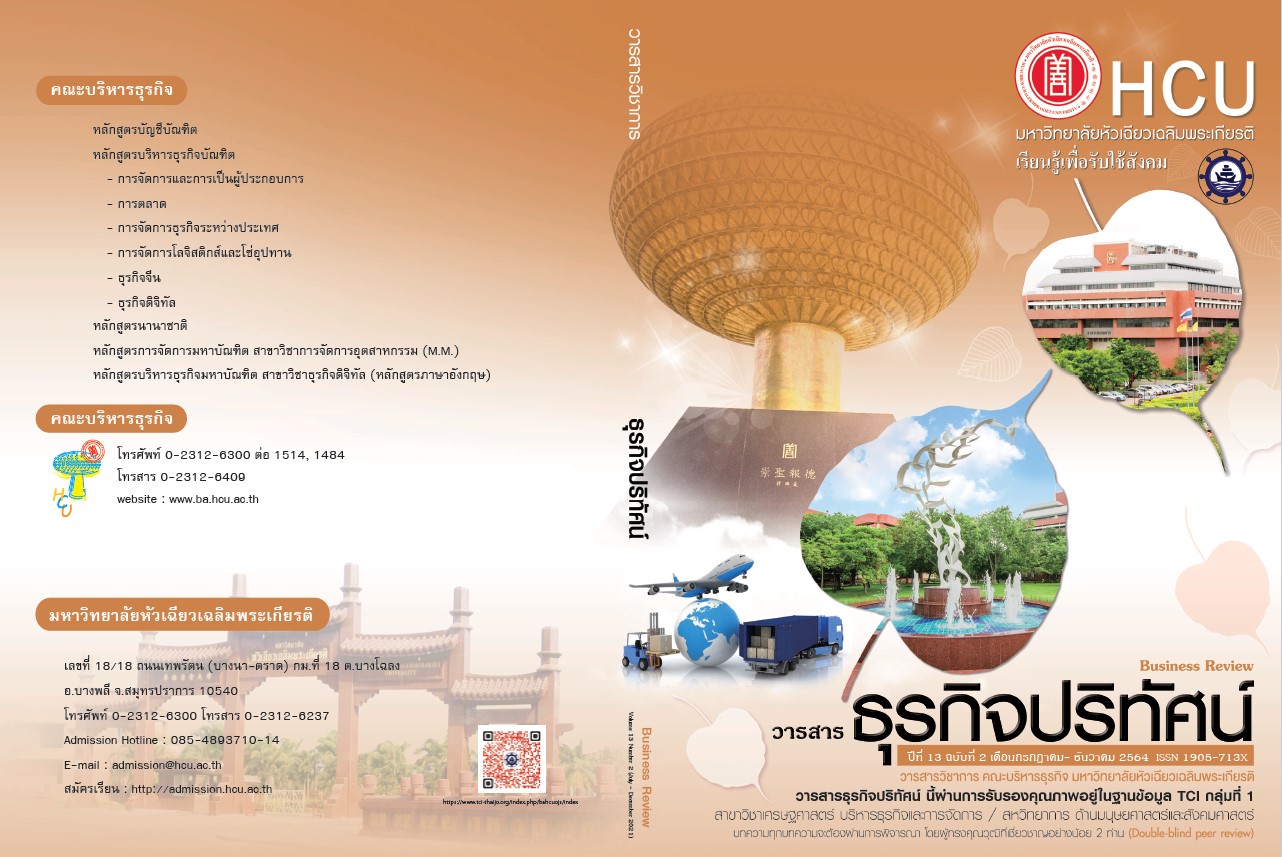ความสัมพันธ์เชิงสาเหตุของการจัดการประสบการณ์ในร้านสปา คุณภาพการบริการของร้านสปา และความพึงพอใจของลูกค้าที่ส่งผลต่อความภักดีของผู้ใช้บริการเดย์สปาในเขตกรุงเทพมหานคร
คำสำคัญ:
การจัดการประสบการณ์ในร้านสปา, คุณภาพการบริการในร้านสปา, ความพึงพอใจ, ความภักดี, เดย์สปาบทคัดย่อ
อุตสาหกรรมสปาเป็นส่วนหนึ่งของการท่องเที่ยวเชิงสุขภาพ ประเทศไทยถูกมองว่าเป็นจุดหมายปลายทางแห่งสปาในกลุ่มนักท่องเที่ยว เห็นได้จากมูลค่าอุตสาหกรรมของสปาไทยที่เติบโตขึ้นอย่างต่อเนื่อง งานวิจัยนี้มีวัตถุประสงค์เพื่อศึกษาอิทธิพลทางตรงและทางอ้อมของความสัมพันธ์เชิงสาเหตุระหว่างตัวแปรด้านการจัดการประสบการณ์ในร้านสปา คุณภาพการบริการ ความพึงพอใจ และความภักดีของลูกค้าในเขตกรุงทพมหานคร ใช้ระเบียบวิธีวิจัยเชิงปริมาณ เก็บข้อมูลโดยใช้แบบสอบถาม กลุ่มตัวอย่าง คือ ลูกค้าชาวไทยที่เคยใช้บริการเดย์สปาในกรุงเทพมหานครจำนวน 400 คน เลือกกลุ่มตัวอย่างแบบเจาะจง วิเคราะห์ข้อมูลด้วยค่าสถิติพื้นฐานและการวิเคราะห์สมการเชิงโครงสร้าง
ผลการศึกษา พบว่าการจัดการประสบการณ์ในร้านสปามีอิทธิพลทางตรงต่อความพึงพอใจของลูกค้าและความภักดีของลูกค้า โดยคุณภาพการบริการของร้านสปามีอิทธิพลทางตรงต่อความพึงพอใจแต่ไม่มีอิทธิพลทางตรงต่อความภักดีของลูกค้า นอกจากนี้ การจัดการประสบการณ์ในร้านสปาและคุณภาพการบริการของร้านสปามีอิทธิพลทางอ้อมต่อความภักดีของลูกค้าผ่านความพึงพอใจของลูกค้า
เอกสารอ้างอิง
กองสถานประกอบการเพื่อสุขภาพ กรมสนับสนุนกิจการเพื่อสุขภาพ. (2564). สืบค้นจาก http://spa.hss.moph.go.th/count_data.php เมื่อวันที่ 29 เมษายน 2564
Abbas, B., Ghaleb, A.-a., and EL-refae, A. (2012). The Relationships Between Service Quality, Satisfaction, and Behavioral Intention of Malaysian Spa Center Customers. International Journal of Business and Social Science, 3(1), 198-205.
Anaya-Aguilar, R., Gemar, G., and Anaya-Aguilar, C. (2021). Factors Associated with Spa Tourists' Satisfaction. Mathematics, 9(332), 1-14.
Barlow, J., and Maul, D. (2000). Emotional Value-Creating Strong Bonds with Your Customers. San Francisco: Berrette-Koehler Publishers.
BMI Research. (2017). Thailand Tourism Report Q2 2017. ISSN: 1747-9037.
Bujisic, M., Bilgihan, A., and Smith, S. (2015). Relationship Between Guest Experience, Personality Characteristics, and Satisfaction: Moderating Effect of Extraversion and Openness to Experience. Tourism Analysis, 20, 25-38.
Cardozo, R. N. (1965). Customer Satisfaction: Laboratory Study and Marketing in Action. Journal of Marketing Research, 2, 244-249.
Carmen, R., Wilson, V., and Betsy L., M. (2007). Understanding Power and Rules of Thumb for Determining Sample Sizes. Tutorials in Quantitative Methods for Psychology, 3(2), 43-50.
Davidson, R. (1992). Tourism in Europe. London: Pitman Publishing.
Division of Research Administration and Education Quality Assurance. (2016). The Thailand 4.0 Model Blueprint: Driving the Country to Properousity. Stability and Sustainability. Retrieved from http://www.libarts.up.ac.th/v2/img/Thailand-4.0.pdf on 10 July 2017
Fatma, S. (2014). Antecedents and Consequences of Customer Experience Management - A Literature Review and Research Agenda. International Journal of Business and Commerce, 3(6), 32-49.
Fornell, C., Johnson, M. D., Anderson, E.W., Cha, J., and Bryant, B. E. (1996). The American Customer Satisfaction Index: Nature, Purpose and Findings. Journal of Marketing 60, 7-18.
Hair, J. F., Black, W. C., Babin, B. J., and Anderson, R. E. (2010). Multivariate Data Analysis (7 Ed.). Upper Saddle River, NJ: Prentice Hall.
Khan, I., Garg, R. J., and Rahman, Z. (2015). Customer Service Experience in Hotel Operations: An Empirical Analysis. Procedia - Social and Behavioral Sciences, 189, 266-274.
Krungsri Bank Public Company. (2005). Economic Benefits via Service Industry. Economics Outlook. Retrieved on 10 November 2020 from http://www.krungsri.com/PDF/ECONOMY/ANALYSIS/oct47_02_pdf
McDougall, G. H.G., and Levesque, T. (2000). Customer Satisfaction with Services: Putting Perceived Value into the Equation. Journal of Service Marketing,14(5), 392-410.
Meyer, C., and Schwager, A. (2007). Understanding Customer Experience. Harvard Business Review, 85(2), 117-127.
Loke, Z. (2020). Investigation of Medical and Wellness Tourists of A Hungarian Spa to Explore Relationships Between Service Quality, Customer Satisfaction and Loyalty. The Central European Journal of Regional Development and Tourism, 12(1), 102-118.
Lomax, R. G., and Schumacker, R. E. (2012). A Beginner's Guide to Structural Equation Modelling. New York, NY: Routledge Academic.
Lovelock, Christopher H., Wirtz, Jochen. and Keh, Hean Tat. (2002). Services Marketing in Asia: Managing People, Technology and Strategy. London: Prentice-Hall.
Office of Permanent Secretary - Ministry of Tourism and Sports. (2017). The 2017 Survey of Attitude and Satisfaction Among International Tourists. Bangkok: Ministry of Tourism and Sports.
Office of Trade and Logistics Services, Department of International Trade Promotion. (2015). Thai Spa Business. Retrieved on 2nd March 2021 from https://www.ditp.go.th/contents_attach/143532/143532.pdf
Oliver, R. L. (1980). A Cognitive Model of the Antecedents and Consequences of Satisfaction Decisions. Journal of Marketing Research, 17, 460-469.
Oliver, R. L. (1997). Satisfaction: A Behavioral Perspective on the Consumer. New York: McGraw-Hill.
Parasuraman, A., Zeithaml, V., and Berry, L. (1988). SERVQUAL: A Multiple-Item Scale for Measuring Consumer Perceptions of Service Quality. Journal of Retailing, 64(1), 12-40.
Piriyapada, S. (2020). A Path Analysis of the Influence on Customer Experience and Brand Prestige on Chinese Visitor Loyalty in Luxury Wellness Service. Journal of Business Administration, Thammasat University, 43(167), 82-105.
Quintela, J., Correia, A., and Antunes, J. (2011). Service Quality in Health and Wellness Tourism - Trend in Portugal. International Journal of Business, Management and Social Sciences, 2(3), 1-8.
Rad, N. F., Som, A. P., and Zainuaddin, Y. (2010). Service Quality and Patients' Satisfaction in Medical Tourism. World Applied Sciences Journal, 10, 24-30.
Rawson, A., Duncan, E. and Jones, C. (2013). The truth about customer experience. Harvard Business Review, Vol. 91 No. 9, pp. 90-98.
Rust, R. T., and Oliver, R. L. (1994). Service quality: Insights and Managerial Implications from the Frontier. In R.T. Rust & R.L. Oliver (Eds.), Service Quality: New Directions in Theory and Practice (pp. 1–20). Thousand Oaks, CA: Sage Publications.
Sarasin, K. (2020). BCG Model General Assembly in the Field of Tourism. Retrieved 13th May 2021 from https://www.nstda.or.th/th/news/13419-bcg-conference-2020
Sundbo, J., and Darmer, P. (2008). Creating Experiences in the Experience Economy. Cheltenham: Edward Elgar Publishing.
Tapar, A. V., Dhaigude, A. S., and Jawed, M. S. (2017). Customer Experience-Based Satisfaction and Behavioural Intention in Adventure Tourism: Exploring the Mediating Role of Commitment. Tourism Recreation Research, 42(3), 344-355.
Thipbharos, P., and Sivapitak, S. (2020). The Characteristics of the Business Operations of Day Spa Enterpreneurs in Thailand. Saint John's Journal, 370-378.
Villnger, N.D.(2008).Using Management Frameworks to Understand Tourism in Thailand: Challenges in the Industry 1997-2007. Journal of Global Business Issues. 2(2): 157-164.
Vryoni, S., Bakirtzoglou, P., and Ioannou, P. (2017). Customers' Satisfaction and Service Quality of Spa Centers in Greece. Acta Kinesiologica, 11, 12-18.
Wetprasit, P. (2019). Evaluation of Tourists' Spa Experiences in Thailand. Journal of International Studies, 9(1), 107-137.
Wijaithammarit, S., and Taechamaneestit, T. (2012). The Impact of Customer Experience Management on Customer Loyalty of Supercenter's Shopper in Thailand. International Journal of e-Education, e-Business, e-Management, e-Learning, 2(6), 473-477.
Zeithaml, V. A., and Bitner, M. J. (2003). Service Marketing: Integrating Customer Focus Across the Firm. 3rd ed. Boston: McGraw-Hill.
Zomerdijk, L. G. and Voss, C. A. (2011). NSD Processes and Practices in Experiential Services. Journal of Product Innovation Management, vol. 28, no. 1, 63–80.
ดาวน์โหลด
เผยแพร่แล้ว
รูปแบบการอ้างอิง
ฉบับ
ประเภทบทความ
สัญญาอนุญาต
บทความที่ได้รับการตีพิมพ์จะเป็นลิขสิทธิ์ของวารสารธุรกิจปริทัศน์
ข้อความที่ปรากฏในบทความแต่ละเรื่องในวารสารวิชาการเล่มนี้เป็นความคิดเห็นส่วนตัวของผู้เขียนแต่ละท่านไม่เกี่ยวข้องกับมหาวิทยาลัยหัวเฉียวเฉลิมพระเกียรติ และคณาจารย์ท่านอื่น ๆ ในมหาวิทยาลัยฯ แต่อย่างใด ความรับผิดชอบองค์ประกอบทั้งหมดของบทความแต่ละเรื่องเป็นของผู้เขียนแต่ละท่าน หากมีความผิดพลาดใด ๆ ผู้เขียนแต่ละท่านจะรับผิดชอบบทความของตนเองแต่ผู้เดียว





